TN State Board 11th Computer Science Important Questions Chapter 2 Number Systems Part 1
Question 1.
Define word length.
Answer:
Word length refers to the number of bits processed by a Computer’s CPU. A word length can have 8 bits, 16 bits, 32 bits and 64 bits (Present Computers use 32 bits or 64 bits).
Question 2.
Define byte.
Answer:
A collection of 8 bits is called Byte. A byte is considered as the basic unit of measuring the memory size in the computer.
![]()
Question 3.
What is a bit?
Answer:
A bit is the short form of Binary digit which can be ‘0’ or ‘ 1 ’. It is the basic unit of data in computers.
Question 4.
What is Decimal Number System?
Answer:
It consists of 0, 1, 2, 3, 4, 5, 6, 7, 8, 9 (10 digits). It is the oldest and most popular number system used in our day-to-day life. In the positional number system, each decimal digit is weighted relative to its position in the number. It means that each digit in the number is multiplied by 10 raised to a power corresponding to that digit’s position.
Question 5.
What is meant by Octal Number System?
Answer:
Octal number system uses digits 0, 1, 2, 3, 4, 5, 6 and 7 (8 digits). Each octal digit has its own positional value or weight as a power of 8.
![]()
Question 6.
Convert (547)<sub>8</sub> to its decimal equivalent?
Answer:
The Octal sequence (547)<sub>8</sub> has the decimal equivalent:
(547)8 = 5 × 82 + 4 × 81 + 7 × 80
= 5 × 64 + 4 × 8 + 7 × 1
= 320 + 32 + 7 = (359)10
Question 7.
(11.011)2 convert into decimal number.
Answer:
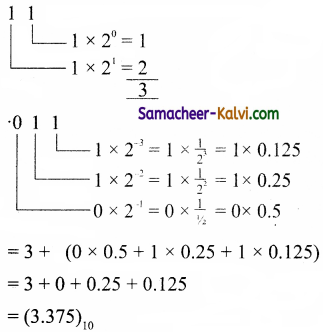
= 3 + (0 × 0.5 + 1 × 0.25 + 1 × 0.125)
= 3 + 0 + 0.25 + 0.125 = (3.375)10
![]()
Question 8.
(6213)8 convert into binary number.
Answer:
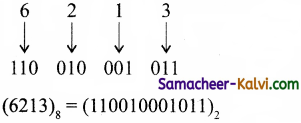
Question 9.
What is a character set?
Answer:
In general, 26 uppercase letters, 26 lowercase letters, 0 to 9 digits and special characters are used in a computer is called character set. All these character set are denoted through numbers only.
Question 10.
Convert (65)10 into its equivalent binary number.
Answer:
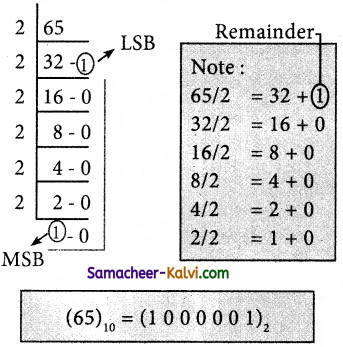
![]()
Question 11.
How will you convert decimal to octal? Give example.
Answer:
To convert Decimal to Octal, “Repeated Division by 8” method can be used. Here, we have to divide the given number by 8.
Eg: Convert (65)10 into its equivalent Octal Number.

Question 12.
Write octal numbers and their binary equivalent.
Answer:
| Octal | Binary Equivalent |
| 0 | 000 |
| 1 | 001 |
| 2 | 010 |
| 3 | 011 |
| 4 | 100 |
| 5 | 101 |
| 6 | 110 |
| 7 | 111 |
![]()
Question 13.
In what ways the numbers are represented in computers?
Answer:
The numbers are represented in computers in different ways:
(i) Signed Magnitude representation.
(ii) 1 ’s Complement.
(iii) 2’s Complement.
Question 14.
Convert (11010110)2 into octal equivalent.
Answer:

Question 15.
Convert the following binary numbers to decimal
(i) 11101,
(ii) 1011010.
Answer:
(i) 11101
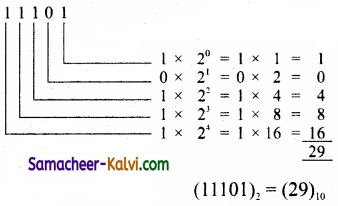
(ii) 1011010
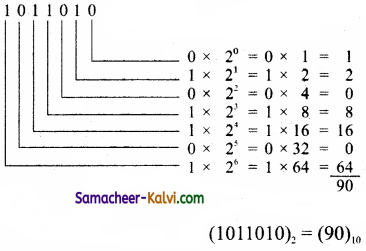
![]()
Question 16.
Convert (3EF)16 to decimal.
Answer:
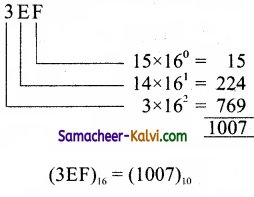
Question 17.
Convert (111011)2 into its equivalent decimal number.
Answer:
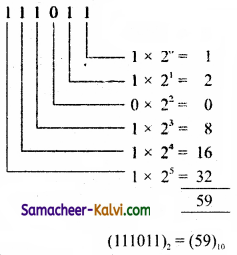
Question 18.
Write short note on hexadecimal number system.
Answer:
A hexadecimal number is represented using base 16. Hexadecimal or Hex numbers are used as a shorthand form of binary sequence. This system is used to represent data in a more compact manner. Since 16 symbols are used, 0 to F, the notation is called hexadecimal. The first 10 symbols are the same as in the decimal system, 0 to 9 and the remaining 6 symbols are taken from the first 6 letters of the alphabet sequence, A to F, where A represents 10, B is 11, C is 12, D is 13, E is 14 and F is 15.
Eg: The hexadecimal sequence (25)16 has the decimal equivalent:
(25)<sub>16</sub> = 2 × 16<sup>1</sup> + 5 × 16<sup>0</sup>
= 32 + 5 = (37)<sub>10</sub>
![]()
Question 19.
Write the hierarchy of data representation.
Answer:
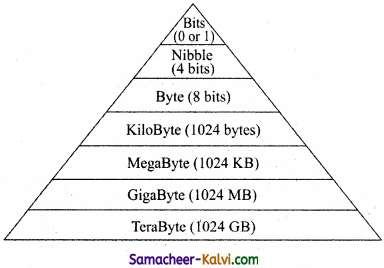
Question 20.
Write the steps for binary to decimal conversion.
Answer:
To convert Binary to Decimal we can use
positional notation method.
Step 1: Write down the Binary digits and list the powers of 2 from right to left (Positional Notation)
Step 2: For each positional notation written for the digit, now write the equivalent weight.
Step 3: Multiply each digit with its corresponding weight.
Step 4: Add all the values.
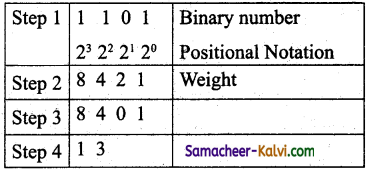
Question 21.
How will you convert binary to octal?
Answer:
Step 1: Group the given binary number into 3 bits from right to left.
Step 2: You can add preceding 0 to make a group of 3 bits if the left most group has less than 3 bits.
Step 3: Convert equivalent octal value using “2’s power positional weight method”.
Eg: Convert (11010110)2 to its Octal equivalent.
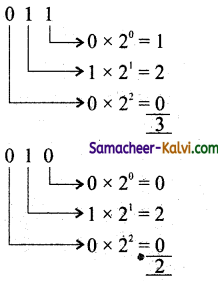
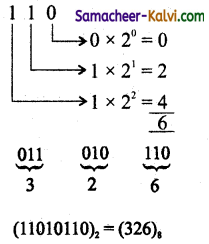
![]()
Question 22.
Write the steps for converting binary to hexadecimal.
Answer:
Step 1: Group the given number into 4 bits from right to left.
Step 2: You can add preceding 0’s to make a group of 4 bits if the left most group has less than 4 bits.
Step 3: Convert equivalent Hexadecimal value using “2’s power positional weight method”.
Eg: Convert (111 1010110)2 to Hexadecimal.
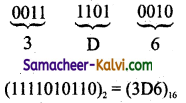
[Note: 0’s are added to the left most group to make it a group of 4 bits]
Question 23.
Write the steps for octal to decimal conversion.
Answer:
To convert octal to decimal, we can use positional notation method.
(i) Write down the octal digits and list the powers of 8 from right to left(Positional Notation).
(ii) For each positional notation of the digit write the equivalent weight.
(iii) Multiply each digit with its corresponding weight.
(iv) Add all the values.
Eg: Convert (1265)8 to equivalent Decimal number.
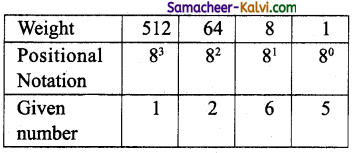
(1265)8 = 512 × 1 + 64 × 2 + 8 × 6 + 1 × 5
= 512 + 128+ 18 + 5
(1265)8 = (693)10
![]()
Question 24.
Write the steps for converting hexadecimal to decimal.
Answer:
To convert Hexadecimal to Decimal we canuse positional notation method.
(i) Write down the Hexadecimal digits and list the powers of 16 from right to left (Positional Notation).
(ii) For each positional notation written for the. digit, now write the equivalent weight.
(iii) Multiply each digit with its corresponding weight.
(iv) Add all the values to get one final value.
Eg: Convert (25F)16 into its equivalent Decimal number.
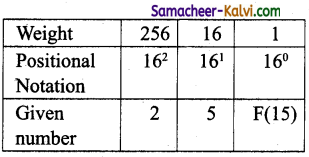
(25F)16 = 2 × 256 + 5 × 16 + 15 × 1
= 512 + 80 + 15
(25F)16 = (607)10
Question 25.
Write short note on signed magnitude representation.
Answer:
The value of the whole numbers can be determined by the sign used before it. If the number has ‘+‘ sign or no sign it will be considered as positive. If the number has ‘—‘ sign it will be considered as negative.
Eg: +43 or 43 is a positive number.
– 43 is a negative number.
In signed binary representation, the left most bit is considered as sign bit. If this bit is O, it is a positive number and if it is 1, it is a negative number. Therefore a signed binary number has 8 bits, only 7 bits used for storing values (magnitude) and the 1 bit is used for sign.
+ 43 is represented in memory as follows:
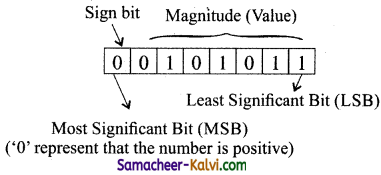
– 43 is represented in memory as follows:
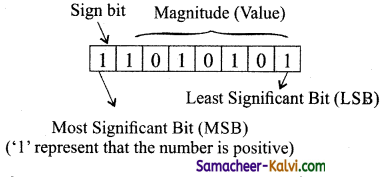
![]()
Question 26.
Write 2’s complement procedure with example.
Answer:
The 2’s complement method for negative number is as follows:
(i) Invert all the bits in the binary sequence
(i.e., change every 0 to 1 and every 1 to 0 i.e.,1‘s complement).
(ii) Add I to the result to the Least Significant Bit (LSB).
Eg: 2’s Complement represent of (-24)10
Binary equivalent of +24 = 11000
8bit format = 00011000
1’s complement = 11100111
Add 1 to LSB = +1
2’s complement of -24 = 11101000
Question 27.
Write short note unicode.
Answer:
Unicode is used in most of the modem computers. The popular coding scheme after ASCII is Unicode. ASCII can represent only 256 characters. ‘English and European Languages alone can be handled by ASCII.
Languages like Tamil, Malayalam, Kannada and Telugu could not be represented by ASCII. Hence, the Unicode was generated to handle all the coding system of Universal languages. Unicode is 16 bit code and can handle 65536 characters.
![]()
Question 28.
Give the steps to convert fractional binary to decimal equivalent with example.
Answer:
Step 1:
Convert integral part of Binary to Decimal equivalent using positional notation method.
Step 2:
To convert, the fractional part of binary to its decimal equivalent.
Step 2.1:
Write down the Binary digits in the fractional part.
Step 2.2:
For all the digits write powers of 2 from left to right starting from 2-1, 2-2, 2-3, ………….2-n, now write the equivalent weight.
Step 2.3:
Multiply each digit with its corresponding weight.
Step 2.4:
Add all the values which you obtained in Step 2.3.
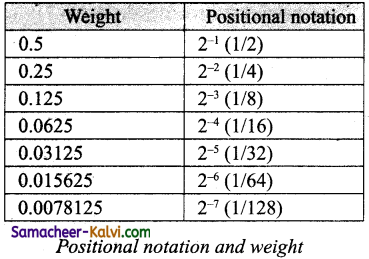
Step 3:
To get final answer write the integral part (after conversion), followed by a decimal point(.) and the answer arrived at
Step 2.4.
Eg: Convert the given Binaxy number(11.011)2 into its decimal equivalent Integer part
(11)2 = 3.
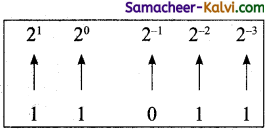
3 + (0 × 0.5 + 1 × 0.25 + 1 × 0.125) = 3.375
3 + 0.75 = 3.75
(11.011)2 = (3.375)10
![]()
Question 29.
Explain in detail the different encoding systems used for computer.
Answer:
There are several encoding systems used for computer. They are –
(i)Binary Coded Decimal (BCD):
It is 26 bit encoding system. It can handle 26 = 64 characters only. This encoding system is not in the practice right now.
(ii)American Standard Code for information Interchange (ASCII):
This is the most popular encoding system recognized by United States. Most of the computers use this system. This encoding system can handle English characters only. This can handle 2<sup>7</sup> bit which means 128 characters. Here each character has individual number.
The new edition (version) ASCII – 8, has 2<sup>8</sup> bits and can handle 256 characters represented from 0 to 255 unique umbers.
The ASCII code equivalent to the uppercase letter ‘A’ is 65. The binary representation of ASCII (7 bit) value is 1000001. Also 01000001 in ASCII-8 bit.
(iii)Extended Binary Coded Decimal Interchange Code (EBCDIC):
This is similar to ASCII Code with 8 bit representation. This coding system is formulated by International Business Machine(IBM). The coding system can handle 256 characters. The input code in ASCII can be converted to EBCDIC system and vice – versa.
(iv)Indian Standard Code for Information Interchange (ISCII):
ISCII is the system of handling the character of Indian local languages. This is a 8-bit coding system and can handle 256 (2<sup>8</sup>) characters. It is formulated by the department of Electronics in India in the year 1986- 88 and recognized by Bureau of Indian Standards (BIS). Now this coding system is integrated with Unicode.
(v) Unicode:
This coding system is used in most of the modem computers. The popular coding scheme after ASCII is Unicode. ASCII can represent only 256 characters. Therefore English and European Languages alone can be
handled by ASCII. Languages like Tamil, Malayalam, Kannada and Telugu could not be represented by ASCII. Hence, the Unicode was generated to handle all the coding system of Universal languages. This is 16 bit code and can handle 65536 characters.
Question 30.
Identify the number system for the following numbers.
Answer:

![]()
Question 31.
State whether the following numbers are valid or not. If invalid, give reason.
Answer:

Question 32.
Convert the following Decimal numbers to its equivalent Binary, Octal, Hexadecimal.
(i) 1920,
(ii) 255,
(iii) 126.
Answer:
(i) 1920
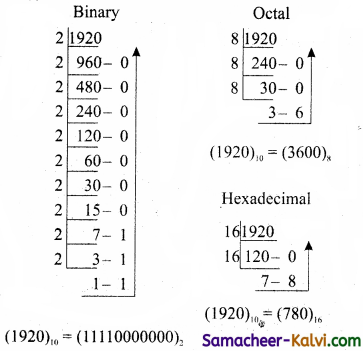
(ii) 255
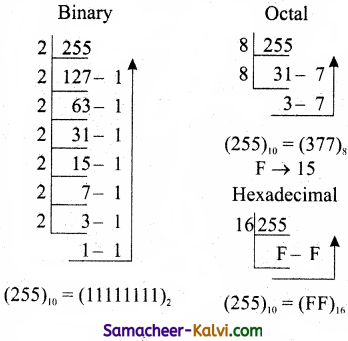
(iii) 126
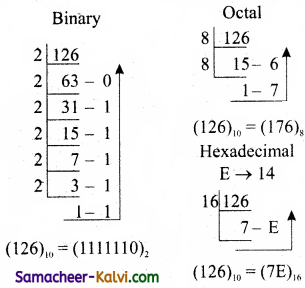
![]()
Question 33.
Convert the given Binary number into its equivalent Decimal, Octal and Hexadecimal number.
(i) 101110101, (ii) 1011010, (iii) 101011111.
(i) 101110101 into Decimal number
Answer:
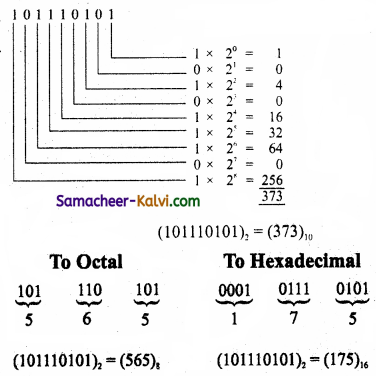
(ii) 1011010 to Decimal
Answer:
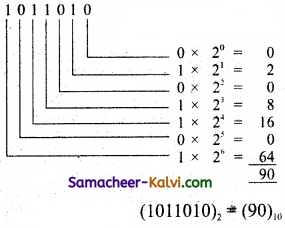
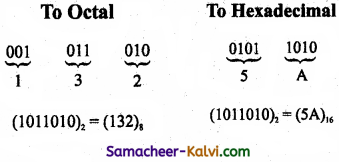
(iii) 101011111 to Decimal
Answer:
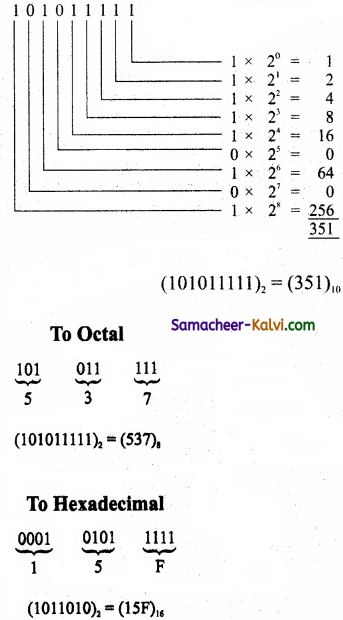
![]()
Question 34.
Convert the foltowing Octal numbers into Binary numbers.
(a) 472, (b) 145, (c) 347, (d) 6247, (e) 645.
(a) 472
Answer:
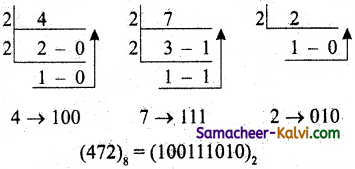
(b) 145
Answer:
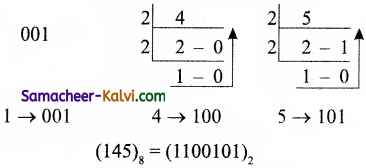
(c) 347
Answer:
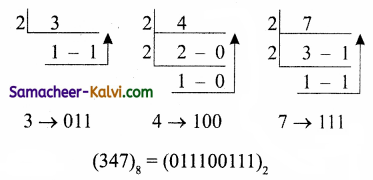
(d) 6247
Answer:
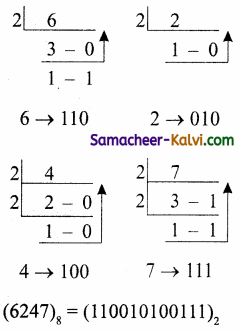
(e) 645
Answer:
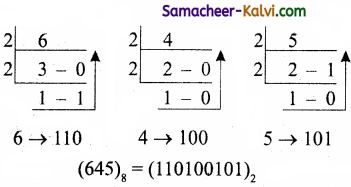
![]()
Question 35.
Convert the following Hexadecimal numbers to Binary numbers:
(a) A6, (b) BE, (c) 9BC8, (d) BC9.
(a) A6
Answer:
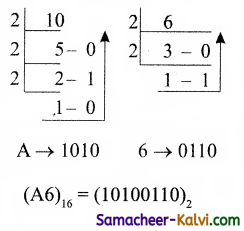
(b) BE
Answer:
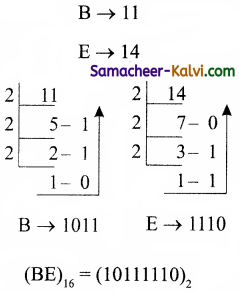
(c) 9BC8
Answer:
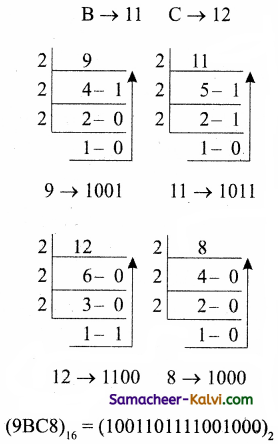
(d) BC9
Answer:
B → 11 C → 12
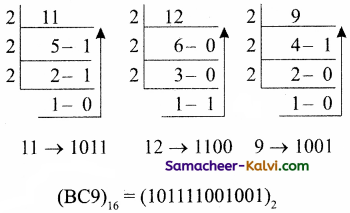
![]()
Question 36.
Write the l’s complement number and 2’s complement number for the following decimal numbers:
(a) 22 (b) -13 (c) -65 (d) -46
(a) – 22 → 101102
Answer:
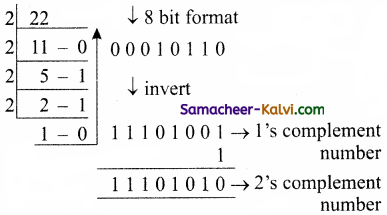
(b) -13 → 1101
Answer:
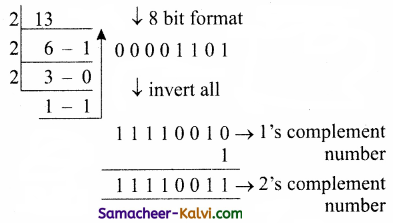
(c) -65 → 1000001
Answer:
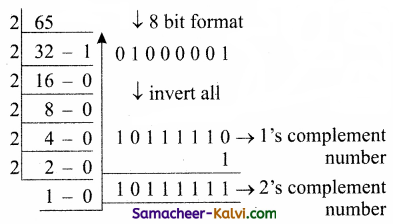
(d) -46 → 1011102
Answer:
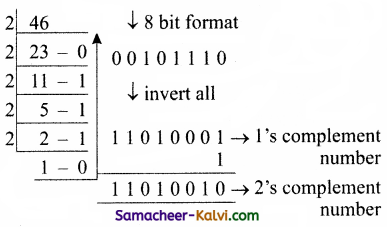
![]()
Question 37.
Perform the following binary computations:
(a) 1010 + 1510
(b) – 1210 + 510
(c) 1410 – 1210
(d) (-2)10 – (- 610).
(a) 1010 + 1510
Answer:
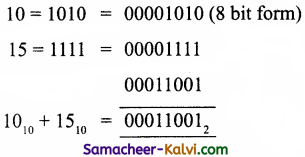
(b) – 1210 + 510
Answer:
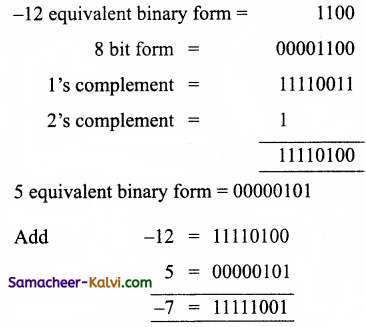
(c) 1410 – 1210
Answer:
14 = 1110 = 00001110
– 12 = 1100 = 00001100

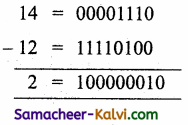
[The final carry bit is lost because it cannot be accommodated in the 8 – bit register]
(d) (-2)10 – (- 610)
Answer:
-2 = 10
8 bit from = 00000010
1’s complement = 11111101
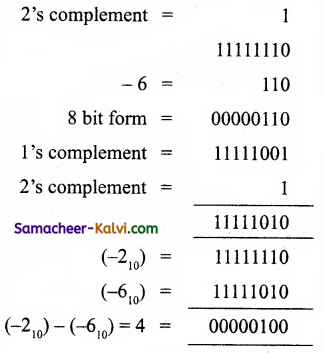
![]()
Question 38.
What is data?
Answer:
The term data comes from the word datum, which means a raw fact. The data is a fact about people, places or some objects.
Eg: Let ‘Name’, ‘Age’, ‘Class’, ‘Marks’ and ‘Subject’ be some defined variables. Assign a value to each of these variables.
Name = Rajesh
Age = 16
Class = XI
Mark = 65
Subject = Computer Science
Here, the values assigned to the five different variables are called data.
Question 39.
Write the l’s complement procedure.
Answer:
Step 1: Convert the given Decimal number into Binary
Step 2: Check if the binary number contains 8 bits , if less add 0 at the left most bit, to make it as 8 bits.
Step 3: Invert all bits (i.e.,s Change 1 as 0 and 0 as 1)
Question 40.
Convert (46)10 into Binary number.
Answer:
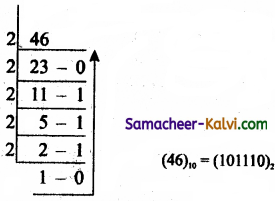
![]()
Question 41.
We cannot find l’s complement for (28)10. State reason.
Answer:
1 ’s complement representation is an easier approach to represent signed numbers. This is for negative numbers only. This (28)10 this whole numbers cannot be determined by negative number because the number whose MSB is 1.
Question 42.
List the encoding systems for characters in memory.
Answer:
There are several encoding systems used for computer. They are
(i) BCD: Binary Coded Decimal.
(ii) EBCDIC: Extended Binary Coded Decimal Interchange Code.
(iii) ASCII: American Standard Code for Information Interchange.
(iv) Unicode
(v) ISCII: Indian Standard Code for Information Interchange.
Question 43.
What is radix of a number system? Give example.
Answer:
A numbering system is a way of representing numbers. The most commonly used numbering system in real life is Decimal number system. Other number systems are Binary, Octal, Hexadecimal number system. Each number system is uniquely identified by its base value or radix. Radix or base is the count of number of digits in each number system. Radix or base is the general idea behind positional numbering system.
Eg:(123)10, (547)8, (1001)2, (25)16.
In this, 10, 8, 2, 16 are radix or base value.
![]()
Question 44.
Write note on binary number system.
Answer:
There are only two digits in the Binary system, 0 and 1. The numbers in the binary system are represented to the base 2 and the positional multipliers are the powers of 2. The left most bit in the binary number is called as the Most Significant Bit (MSB) and it has the largest positional weight. The right most bit is the Least Significant Bit (LSB) and has the smallest positional weight.
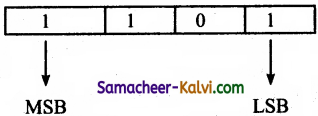
Eg: The binary sequence (1101)2 has the decimal equivalent:
(1101)2 = 1 × 23 + 1 × 22 + 0 × 21 + 1 × 20
= 8 + 4 + 0 + 1 =(13)10
Question 45.
Convert (150)10 into Binary, then convert that Binary number to Octal.
Answer:
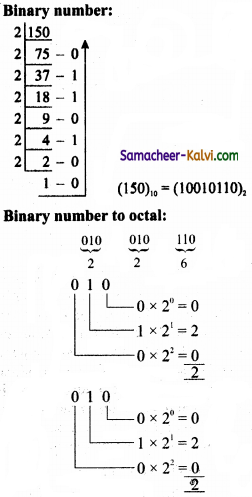
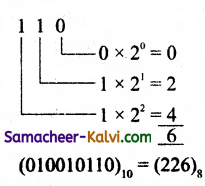
![]()
Question 46.
Write short note on ISCII.
Answer:
ISCII is the system of handling the character of Indian local languages. This is a 8-bit coding system. So it can handle 256 (28) characters. This system is formulated by the department of Electronics in India in the year 1986-88 and recognized by Bureau of Indian Standards (BIS). Now this coding system is integrated with Unicode.
Question 47.
Add: (i)-2210 + 1510;
(ii) 2010 + 2510.
(i) -2210 + 1510
Answer:
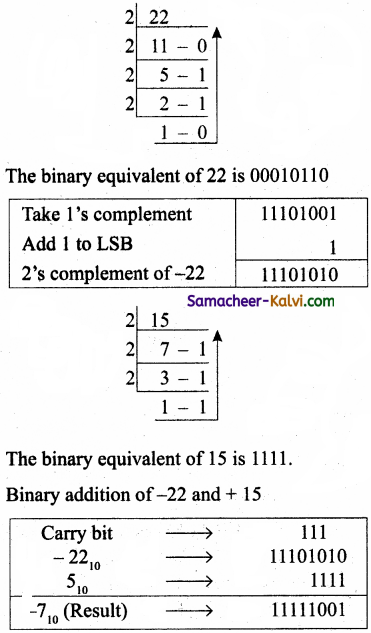
(ii) 20 + 25
Answer:
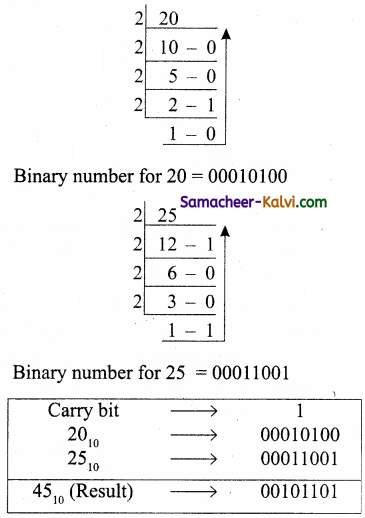
![]()
Question 48.
(a) Write the procedure to convert fractional Decimal to Binary.
(b) Convert (98.46)10 to Binary.
Answer:
(a) The method of repeated multiplication by 2 has to be used to convert such kind of decimal fractions.
The steps involved in the method of repeated multiplication by 2:
Step 1: Multiply the decimal fraction by 2 and note the integer part. The integer part is either 0 or 1.
Step 2: Discard the integer part of the previous product. Multiply the fractional part of the previous product by 2. Repeat Step 1 until the same fraction repeats or terminates (0).
Step 3: The resulting integer part forms a sequence of 0s and Is that become the binary equivalent of decimal fraction.
Step 4: The final answer is to be written from first integer part obtained till the last integer part obtained.
(b) (98.46)10
Answer:
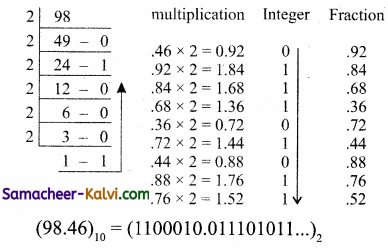
Question 49.
Find 1’s Complement and 2’s Complement for the following Decimal number: (a) – 98,
(b) -135.
(a) – 98
Answer:
First, convert given decimal number into binary.
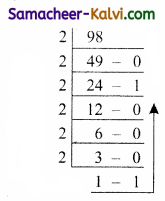
Binary number = 11000102
Second, check binary number as 8 bits, If less add 0 as the left most bit, 01100010
Third, Invert all bits (change 1 as 0 and 0 as 1) 1 ’s complement for 10011101.
2’s complement:
Binary equivalent of + 98 = 1100010
8 bit format = 01100010
1 ’s complement = 10011101
Add 1 to LSB = 1
10011110
2’s complement of – 98 = 100111102
(b) – 135
Answer:
First, convert given decimal number into Binary.
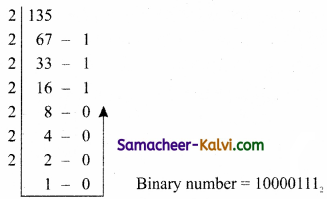
Second, check binary number as 8 bits, If less add 0 at the left most bit. It has 8 bits, 10000111.
Third, Invert all bits (change 1 as 0 and 0 as 1) 1 ’s complement for 01111000.
2’s complement:
Binary equivalent of + 135 = 10000111
8 bit format = 10000111
1 ’s complement = 01111000
Add 1 to LSB = 1
01111001
2’s complement of- 135 = 011110012
![]()
Question 50.
(a) Add 11010102+ 1011012
(b) Subtract 11010112 – 1110102
(a) Add 11010102+ 1011012
Answer:
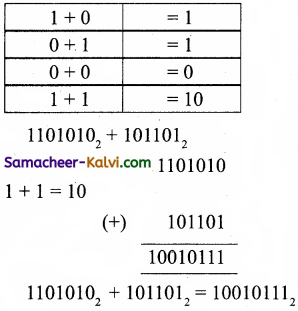
(b) Subtract 11010112 – 1110102
Answer:
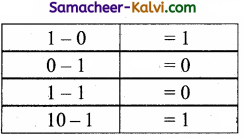
11010112 – 1110102
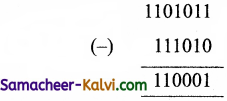
11010112 – 1110102 = 1100012
![]()
Choose the correct answer:
Question 1.
A bit is the short form of:
(a) binary data
(b) binary digit
(c) binary decimal
(d) big digit
Answer:
(b) binary digit
Question 2.
A ________ is a collection of 4 bits.
(a) bit
(b) byte
(c) nibble
(d) word length
Answer:
(c) nibble
Question 3.
A collection of 8 bits is called:
(a) bit
(b) byte
(c) word length
(d) nibble
Answer:
(b) byte
![]()
Question 4.
2^40 is referred as:
(a) mega
(b) giga
(c) peta
(d) tera
Answer:
(d) tera
Question 5.
2^70 is referred as:
(a) peta
(b) exa
(c) zetta
(d) yotta
Answer:
(c) zetta
Question 6.
1024 GB is referred as :
(a) kilo byte
(b) mega byte
(c) giga byte
(d) tera byte
Answer:
(d) tera byte
![]()
Question 7.
____________ are used to represent characters in a text.
(a) Bits
(b) Bytes
(c) Nibble
(d) Wordlength
Answer:
(b) Bytes
Question 8.
The ASCII value for blank space is:
(a) 32
(b) 91
(c) 48
(d) 65
Answer:
(a) 32
Question 9.
The ASCII value for numeric 0 is:
(a) 32
(b) 97
(c) 48
(d) 65
Answer:
(c) 48
![]()
Question 10.
Each number system is uniquely identified by its:
(a) decimal value
(b) binary value
(c) base value or radix
(d) octal value
Answer:
(c) base value or radix
Question 11.
The range of ASCII values for lower case alphabets is from:
(a) 97 to 122
(b) 65 to 90
(c) 98 to 122
(d) 97 to 123
Answer:
(a) 97 to 122
Question 12.
The range of ASCII values for upper case alphabets is from:
(a) 97 to 122
(b) 65 to 90
(c) 66 to 90
(d) 65 to 97
Answer:
(b) 65 to 90
![]()
Question 13.
The expansion of MSB is:
(a) Most Significant Bit
(b) Most Signed Bit
(c) Must Significant Bit
(d) Must Signed Bit
Answer:
(a) Most Significant Bit
Question 14.
The expansion of LSB is:
(a) Lower Significant Bit
(b) Least Significant Bit
(c) Lower Signed Bit
(d) Least Signed Bit
Answer:
(b) Least Significant Bit
Question 15.
Radix of octal number is:
(a) 2
(b) 10
(c) 16
(d) 8
Answer:
(d) 8
![]()
Question 16.
The binary sequence (1101)2 has the decimal equivalent:
(a) (25)10
(b) (15)10
(c) (17)10
(d) (13)10
Answer:
(d) (13)10
Question 17.
In hexadecimal C represents:
(a) 11
(b) 10
(c) 12
(d) 15
Answer:
(c) 12
Question 18.
The simplest method to represent negative binary numbers is called:
(a) signed magnitude
(b) unsigned magnitude
(c) magnitude bit
(d) unmagnitude bit
Answer:
(a) signed magnitude
![]()
Question 19.
EBDIC coding system can handle characters.
(a) 64
(b) 255
(c) 256
(d) 128
Answer:
(c) 256
Question 20.
The most commonly used coding scheme is the:
(a) Binary Coded Decimal
(b) Extended Binary Coded Decimal Interchange Code
(c) Indian Standard Code for Information Interchange
(d) American Standard Code for Information Interchange
Answer:
(d) American Standard Code for Information Interchange
Question 21.
Which is the basic unit of measuring the memory size in the computer?
(a) bit
(b) byte
(c) nibble
(d) word length
Answer:
(b) byte
![]()
Question 22.
What is the most commonly used numbering system in real life?
(a) Binary
(b) Octal
(c) Decimal
(d) Hexadecimal
Answer:
(c) Decimal
Question 23.
Which of the following is octal number?
(a) 1101
(b) 1178
(c) 778
(d) 8005
Answer:
(a) 1101
Question 24.
Which of the following is not a binary number?
(a) 2101
(b) 1000
(c) 1111
(d) 1001
Answer:
(a) 2101
![]()
Question 25.
Which of the following is a Hexadecimal number?
(a) 1234
(b) ABCD
(c) 1001
(d) All the above
Answer:
(d) All the above
Question 26.
Unicode is a ______ bit code.
(a) 8
(b) 16
(c) 32
(d) 64
Answer:
(b) 16
Question 27.
What is the 1 ’s complement for (-24)10?
(a) 00011000
(b) 11100111
(c) 11110011
(d) 11100001
Answer:
(b) 11100111
![]()
Question 28.
Who formulated ASCII coding system?
(a) Microsoft
(b) Oracle
(c) IBM
(d) SVN
Answer:
(c) IBM
Question 29.
What is the ASCII value of A in decimal number?
(a) 65
(b) 66
(c) 67
(d) 68
Answer:
(a) 65
Question 30.
ISCII coding system is formulated by:
(a) Electronics in India
(b) IBM
(c) Oracle corporation
(d) Sun micro systems
Answer:
(a) Electronics in India
![]()
Question 31.
Which coding system is used in most of the modern computers?
(a) ASCII
(b) BCD
(c) ISCII
(d) Unicode
Answer:
(d) Unicode
Question 32.
Unicode scheme is denoted by:
(a) Binary numbers
(b) Octal numbers
(c) Hexadecimal numbers
(d) Decimal numbers
Answer:
(c) Hexadecimal numbers
Question 33.
What is the ASCII value of a in decimal number?
(a) 95
(b) 96
(c) 97
(d) 98
Answer:
(c) 97
![]()
Question 34.
What is the ASCII value of * symbol in Hexadecimal number?
(a) 2B
(b) 2A
(c) 2C
(d) 2D
Answer:
(b) 2A
Question 35.
What is the ASCII value of @ symbol in octal number?
(a) 111
(b) 571
(c) 100
(d) 123
Answer:
(c) 100
Question 36.
Unicode can handle characters.
(a) 65536
(b) 75536
(c) 66535
(d) 85536
Answer:
(a) 65536
![]()
Question 37.
BCD can handle _______ characters only.
(a) 65
(b) 75
(c) 64
(d) 94
Answer:
(c) 64
Question 38.
ASCII can handle characters.
(a) 365
(b) 128
(c) 256
(d) 255
Answer:
(b) 128
Question 39.
________ can handle all the coding system of universal languages.
(a) Unicode
(b) ISCII
(c) EBCDIC
(d) BCD
Answer:
(a) Unicode
![]()
Question 40.
Choose the odd man out:
(a) Bit
(b) Byte
(c) Nibble
(d) IBM
Answer:
(d) IBM
Question 41.
Choose the odd man out:
(a) Octal variable
(b) Logical variable
(c) Binary valued variable
(d) Boolean variable
Answer:
(a) Octal variable
Question 42.
Match the following:
| (i) (1010)2 | (a) Octal |
| (ii) (989)16 | (b) Binary |
| (iii) (750)8 | (c) Decimal |
| (iv) (926)10 | (d) Hexadecimal |
(a) (i) – (d); (ii) – (a); (iii) – (b); (iv) – (c)
(b) (i) – (b); (ii) – (d); (iii) – (a); (iv) – (c)
(c) (i) – (b); (ii) – (a); (iii) – (d); (iv) – (c)
(d) (i) – (d); (ii) – (b); (iii) – (a); (iv) – (c)
Answer:
(b) (i) – (b); (ii) – (d); (iii) – (a); (iv) – (c)
![]()
Question 43.
Match the following:
|
Hexadecimal |
Binary |
| (i) A | (a) 1101 |
| (ii) B | (b) 1010 |
| (iii) D | (c) 1110 |
| (iv) E | (d) 1011 |
(a) (i) – (d); (ii) – (b); (iii) – (a); (iv) – (c)
(b) (i) – (c); (ii) – (d); (iii) – (a); (iv) – (b)
(c) (i) – (b); (ii) – (d); (iii) – (a); (iv) – (c)
(d) (i) – (b); (ii) – (a); (iii) – (d); (iv) – (c)
Answer:
(c) (i) – (b); (ii) – (d); (iii) – (a); (iv) – (c)
Question 44.
Match the following:
| (i) BCD | (a) 0 – 15 |
| (ii) EBCDIC | (b) 65536 characters |
| (in) Unicode | (c) 256 characters |
| (iv) Hexadecimal | (d) 64 characters |
(a) (i) – (d); (ii) – (c); (iii) – (b); (iv) – (a)
(b) (i) – (d); (ii) – (a); (iii) – (b); (iv) – (c)
(c) (i) – (a); (ii) – (b); (iii) – (d); (iv) – (c)
(d) (i) – (c); (ii) – (a); (iii) – (d); (iv) – (b)
Answer:
(a) (i) – (d); (ii) – (c); (iii) – (b); (iv) – (a)
Question 45.
Choose the correct pair.
| Column – I |
Column – II |
| (a) 2 | 011 |
| (b) 4 | 100 |
| (c) 5 | 110 |
| (d) 7 | 010 |
Answer:
(b)
![]()
Question 46.
Choose the incorrect pair.
| Column – I |
Column – II |
| (a) Kilo byte | 2^10 |
| (b) Mega byte | 2^20 |
| (c) Peta byte | 2^50 |
| (d) Exa | 2^70 |
Answer:
(d)
Question 47.
Assertion (A):
The computer can understand only Machine language.
Reason (R):
The Machine language is 0 and 1.
(a) Both A and R are true, and R is the correct explanation for A.
(b) Both A and R are true, but R is not the correct explanation for A.
(c) A is true, but R is false.
(d) A is false, but R is true.
Answer:
(a) Both A and R are true, and R is the correct explanation for A.
Question 48.
Assertion (A):
A numbering system is a way of representing numbers.
Reason (R):
The most commonly used numbering system in real life is Binary number system.
(a) Both A and R are true, and R is the correct explanation for A.
(b) Both A and R are true, but R is not the correct explanation for A.
(c) A is true, but R is false.
(d) A is false, but R is true.
Answer:
(c) A is true, but R is false.
![]()
Question 49.
Assertion (A):
The popular coding scheme after ASCII is Unicode.
Reason (R):
The Unicode was generated to handle all the coding system of universal language.
(a) Both A and R are true, and R is the correct explanation for A.
(b) Both A and R are true, but R is not the correct explanation for A
(c) A is true, but R is false.
(d) A is false, but R is true.
Answer:
(a) Both A and R are true, and R is the correct explanation for A.
Question 50.
A collection of 8 bits is called:
(a) bit
(b) byte
(c) word length
(d) nibble
Answer:
(b) byte
Question 51.
The ASCII value for numeric 0 is:
(a) 32
(b) 97
(c) 48
(d) 65
Answer:
(c) 48
![]()
Question 52.
The expansion of LSB is:
(a) Lower Significant Bit
(b) Least Significant Bit
(c) Lower Significant Bit
(d) Least Signed Bit
Answer:
(b) Least Significant Bit
Question 53.
Which refers to the number of bits processed by a computer’s CPU?
(a) Byte
(b) Nibble
(c) Word length
(d) Bit
Answer:
(c) Word length
Question 54.
How many bytes does 1 KiloByte contain?
(a) 1000
(b) 8
(c) 4
(d) 1024
Answer:
(d) 1024
![]()
Question 55.
Expansion for ASCII:
(a) American School Code for Information Interchange
(b) American Standard Code for Information Interchange
(c) All Standard Code for Information Interchange
(d) American Society Code for Information Interchange
Answer:
(b) American Standard Code for Information Interchange
Question 56.
2^50 is referred as:
(a) kilo
(b) tera
(c) peta
(d) zetta
Answer:
(c) peta
Question 57.
How many characters can be handled in Binary Coded Decimal System?
(a) 64
(b) 255
(c) 256
(d) 128
Answer:
(a) 64
![]()
Question 58.
For 11012 what is the Hexadecimal equivalent?
(a) F
(b) E
(c) D
(d) B
Answer:
(c) D
Question 59.
What is the 1 ’s complement of 00100110?
(a) 00100110
(b) 11011001
(c) 11010001
(d) 00101001
Answer:
(b) 11011001
![]()
Question 60.
Which amongst this is not an Octal number?
(a) 645
(b) 234
(c) 876
(d) 123
Answer:
(c) 876